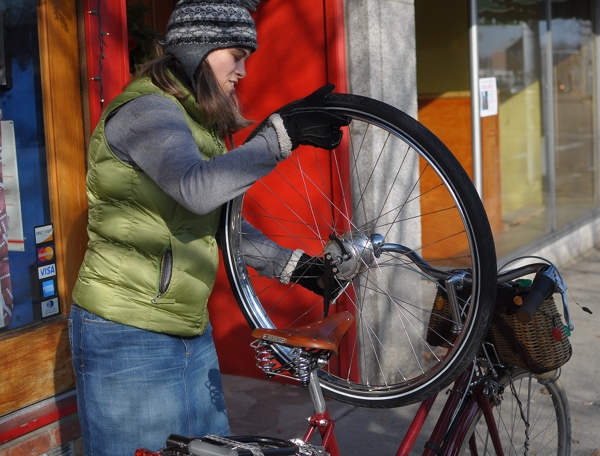 Even though we live close to one another and normally cross paths on our own turf, this weekend I bumped into "cycler" from Biking in Heels 10 miles away - at Harris Cyclery. We'd both taken on projects that ended up throwing us curveballs, and now here we were. Even if you work on your bike yourself, it's good to find a trustworthy bike shop you can turn to just in case - and better still, a specific mechanic whose opinion and work you trust. The fact that I travel 10 miles to see Jim even though there are plenty of bike shops walking distance from my house, speaks for itself.
Even though we live close to one another and normally cross paths on our own turf, this weekend I bumped into "cycler" from Biking in Heels 10 miles away - at Harris Cyclery. We'd both taken on projects that ended up throwing us curveballs, and now here we were. Even if you work on your bike yourself, it's good to find a trustworthy bike shop you can turn to just in case - and better still, a specific mechanic whose opinion and work you trust. The fact that I travel 10 miles to see Jim even though there are plenty of bike shops walking distance from my house, speaks for itself.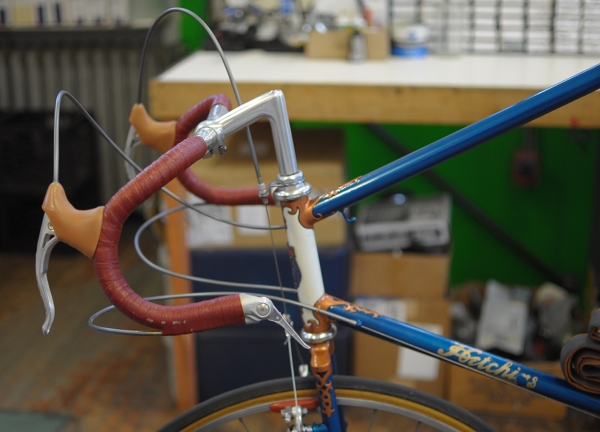 And if you are going to visit your local shop with a "project bike," there is no better time than the winter months. In the off season, bicycle shops tend to be less crowded, which means that they will be able to work on your bike sooner and will have more time to answer your questions. They are also more likely to have the components and accessories you want in stock, since things don't sell out as quickly as in the summer.
And if you are going to visit your local shop with a "project bike," there is no better time than the winter months. In the off season, bicycle shops tend to be less crowded, which means that they will be able to work on your bike sooner and will have more time to answer your questions. They are also more likely to have the components and accessories you want in stock, since things don't sell out as quickly as in the summer.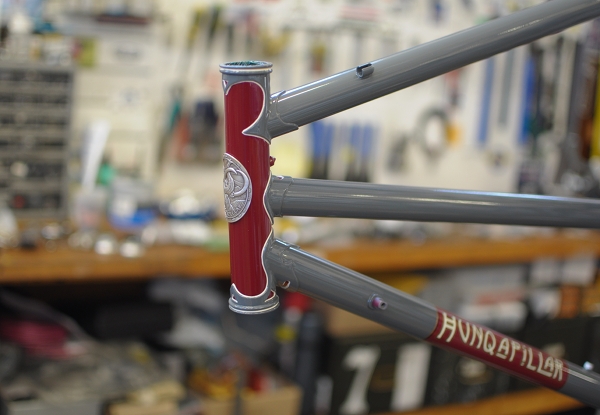 Some new floor models are likely to be available as well, since the shop will actually have time to build them up. This is the first time I've seen theRivendell Hunqapillar- the version with the diagonal "middle tube." The design is definitely not for me and I cannot help but wonder how many people buying this bike will actually be using it in a way that necessitates this construction. But I do appreciate seeing the monsterin person. The wooly mammoth headbadge and the decals are nicely done, as is the lugwork.
Some new floor models are likely to be available as well, since the shop will actually have time to build them up. This is the first time I've seen theRivendell Hunqapillar- the version with the diagonal "middle tube." The design is definitely not for me and I cannot help but wonder how many people buying this bike will actually be using it in a way that necessitates this construction. But I do appreciate seeing the monsterin person. The wooly mammoth headbadge and the decals are nicely done, as is the lugwork. Never seen a seat cluster with a "socketed" seat stay like this before. Any idea what the purpose of this design is, assuming that it is more than aesthetic?
Never seen a seat cluster with a "socketed" seat stay like this before. Any idea what the purpose of this design is, assuming that it is more than aesthetic? Between the Hunqapillar, the flock of otherRivendells, the vintageHetchins, and other exotic specimens, it felt as if lugwork was declaring war on modern bikes and taking over the shop. My own modestly lugged bicycle seemed like an underachiever in comparison - though he held himself proudly and was quite happy to have the mechanic's attention.
Between the Hunqapillar, the flock of otherRivendells, the vintageHetchins, and other exotic specimens, it felt as if lugwork was declaring war on modern bikes and taking over the shop. My own modestly lugged bicycle seemed like an underachiever in comparison - though he held himself proudly and was quite happy to have the mechanic's attention.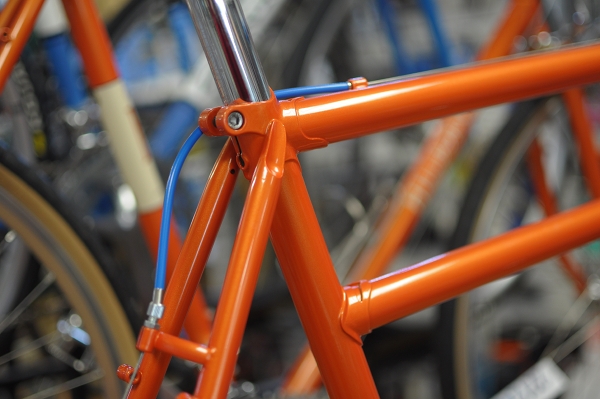 Winter is also the time when bike shops hold end-of-the year sales, where good deals can be found if you are in the market for a new bike. And for those manufacturers whose models do not change year to year, winter is often the last chance to get a bike at the current price tag, before prices go up in the Spring. If you hang around long enough, you might also learn about non-advertised deals, including second hand bikes. Some of the most interesting vintage bicycles never make it to the likes of Craig's List or e-bay, but are sold via word of mouth. Bicycle shops can act as hubs for those types of connections. If you are looking for a particular bike, try asking your bike shop about it - they might just know of a customer, or a friend, who is trying to sell theirs.
Winter is also the time when bike shops hold end-of-the year sales, where good deals can be found if you are in the market for a new bike. And for those manufacturers whose models do not change year to year, winter is often the last chance to get a bike at the current price tag, before prices go up in the Spring. If you hang around long enough, you might also learn about non-advertised deals, including second hand bikes. Some of the most interesting vintage bicycles never make it to the likes of Craig's List or e-bay, but are sold via word of mouth. Bicycle shops can act as hubs for those types of connections. If you are looking for a particular bike, try asking your bike shop about it - they might just know of a customer, or a friend, who is trying to sell theirs.The winter months are infamously slow for the bicycle industry - but as a customer, you can take advantage of that in a way that benefits everyone: You get more personal attention, faster turn-around, and better deals - and the bike shop gets winter business. It's win-win!


 Sonny agreed to pose in the Santa Hat as did all the other horses and ponies and even our cat Murphy who can be see at the end of this blog'
Sonny agreed to pose in the Santa Hat as did all the other horses and ponies and even our cat Murphy who can be see at the end of this blog'










 While in Portland, Maine over the weekend, I rode an Abici bicycle, courtesy of Portland Velocipede. The Co-Habitant and I cycled around town a bit to visit some of our favourite spots from when we lived in the area some time ago. Two things about the city that are of relevance to cyclists: It is hilly, and there are no bike lanes. But not to worry: The hills are short and the lack of bike lanes does not seem to matter. We cycled on the roads, and the biggest obstacle was pedestrian traffic in the waterfront area (It was a Saturday); the cars seemed to be fine with cyclists. At any rate, I felt comfortable enough to get a good impression of the bicycle.
While in Portland, Maine over the weekend, I rode an Abici bicycle, courtesy of Portland Velocipede. The Co-Habitant and I cycled around town a bit to visit some of our favourite spots from when we lived in the area some time ago. Two things about the city that are of relevance to cyclists: It is hilly, and there are no bike lanes. But not to worry: The hills are short and the lack of bike lanes does not seem to matter. We cycled on the roads, and the biggest obstacle was pedestrian traffic in the waterfront area (It was a Saturday); the cars seemed to be fine with cyclists. At any rate, I felt comfortable enough to get a good impression of the bicycle.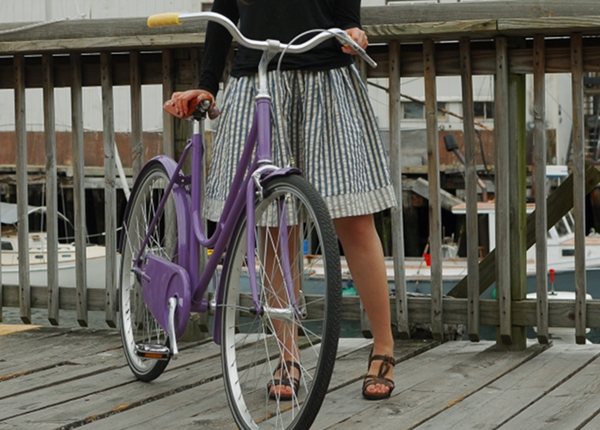 The model I rode was the Abici Granturismo Donna, single speed (also available as a 3-speed), in violet. The colour looks subdued on Abici's website, but in actuality it is highly saturated. I think pastels look good on an Italian bicycle no matter what the colour - though for my personal bike I would prefer something more neutral, like cream or slate gray.
The model I rode was the Abici Granturismo Donna, single speed (also available as a 3-speed), in violet. The colour looks subdued on Abici's website, but in actuality it is highly saturated. I think pastels look good on an Italian bicycle no matter what the colour - though for my personal bike I would prefer something more neutral, like cream or slate gray.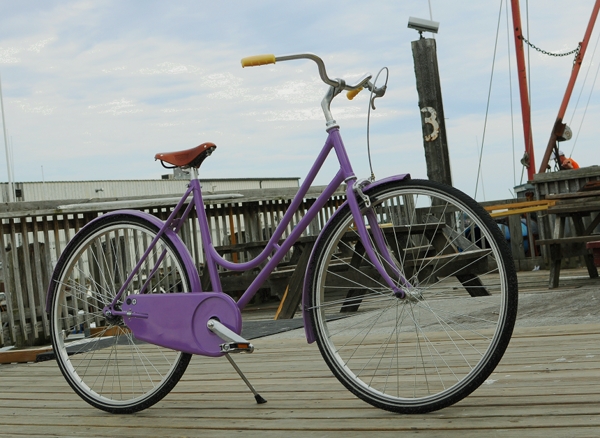 The design of the Abici Granturismois different from classic Dutch bicycles and English roadsters, but typical of an Italian lady's bicycle. The step-through top tube is asymmetrically curved, with the bend happening toward the rear of the bike, unlike a traditional loop-frame. You can see the same design from a number of Italian manufacturers, including Orco Cicli and Bella Ciao. It is also the design of the "Mrs. Cinelli" bicycle I had admired at the Larz Anderson Bicycle Show. (As an aside, I have tried to research the history of this frame style, but have had no success - so would appreciate any information or tips.)
The design of the Abici Granturismois different from classic Dutch bicycles and English roadsters, but typical of an Italian lady's bicycle. The step-through top tube is asymmetrically curved, with the bend happening toward the rear of the bike, unlike a traditional loop-frame. You can see the same design from a number of Italian manufacturers, including Orco Cicli and Bella Ciao. It is also the design of the "Mrs. Cinelli" bicycle I had admired at the Larz Anderson Bicycle Show. (As an aside, I have tried to research the history of this frame style, but have had no success - so would appreciate any information or tips.)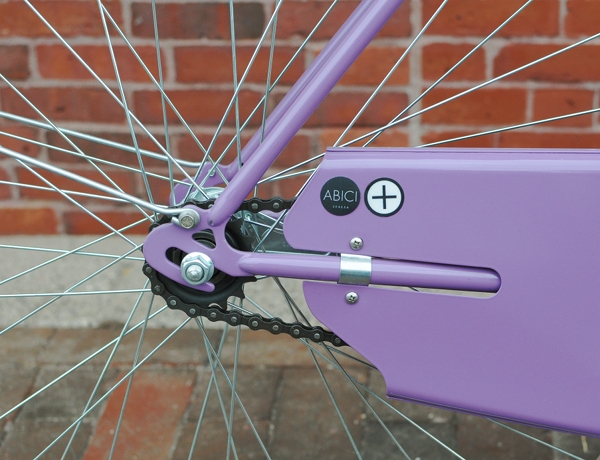 Both the single speed and the 3-speed versions of the Granturismomodel come with a coaster brake and a front caliper brake. The chain is fully enclosed, except for an opening at the rear for easy wheel removal. As far as design goes, the Abici is an appealing bicycle - though a couple of things puzzle me. For example, why was it made with derailleur-style dropouts, if it is designed for internally geared hubs? This is not so much a criticism, as a genuine question. Could it be that they are planning a derailleur version in the future? Also - and this is a minor thing - I was surprised by the lack of headbadge. Is it an intentional act of modesty to place the company's insignia only on a tiny part of the chaincase? If so, it is an interesting concept (but I nonetheless love headbadges!).
Both the single speed and the 3-speed versions of the Granturismomodel come with a coaster brake and a front caliper brake. The chain is fully enclosed, except for an opening at the rear for easy wheel removal. As far as design goes, the Abici is an appealing bicycle - though a couple of things puzzle me. For example, why was it made with derailleur-style dropouts, if it is designed for internally geared hubs? This is not so much a criticism, as a genuine question. Could it be that they are planning a derailleur version in the future? Also - and this is a minor thing - I was surprised by the lack of headbadge. Is it an intentional act of modesty to place the company's insignia only on a tiny part of the chaincase? If so, it is an interesting concept (but I nonetheless love headbadges!). Continuing with the scrutiny of the details, here is the seat cluster. This part of the bicycle is beautiful.
Continuing with the scrutiny of the details, here is the seat cluster. This part of the bicycle is beautiful.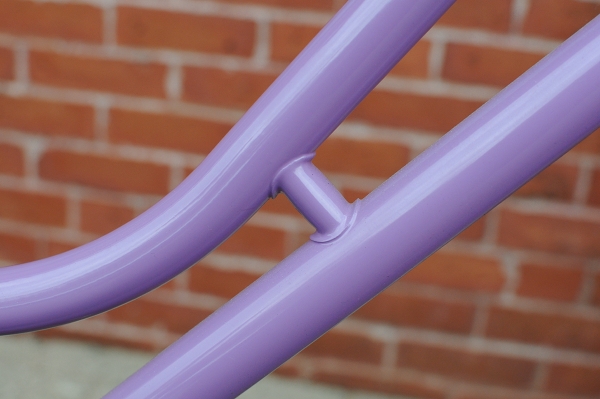 Equally well done is the lugged connector between the top tube and downtube. The Abici is gracefully lugged throughout, except...
Equally well done is the lugged connector between the top tube and downtube. The Abici is gracefully lugged throughout, except... ... yes, except for the welded unicrown fork. The contrast between the wealth of lugwork on other parts of the bike and this fork makes me want to cry. Why Abici, why? I am privy to the wholesale upcharge on lug-crowned forks, and it is not that high.
... yes, except for the welded unicrown fork. The contrast between the wealth of lugwork on other parts of the bike and this fork makes me want to cry. Why Abici, why? I am privy to the wholesale upcharge on lug-crowned forks, and it is not that high. Aside from the fork-crown issue, I have no complaints about the Abici Granturismo. On the contrary, handling and riding it was a pleasant surprise, as it was very different from any other city bicycle I had ridden previously. The main thing, is the sporty handling: from the steep-ish angles, to the aggressive sitting position, it handles like a roadbike that happens to be a step-through. It is fast, responsive, and light.
Aside from the fork-crown issue, I have no complaints about the Abici Granturismo. On the contrary, handling and riding it was a pleasant surprise, as it was very different from any other city bicycle I had ridden previously. The main thing, is the sporty handling: from the steep-ish angles, to the aggressive sitting position, it handles like a roadbike that happens to be a step-through. It is fast, responsive, and light. How light? Without exaggeration, it felt like half the weight of a Pashley or a Gazelle. Of course it had no rear rack, no lights, etc., etc. - but even taking that into account, the weight difference is considerable. I could drag a bike like this up and down the front stairs all day without complaining.Of course the downside to a light, sporty bicycle, is that the ride does not feel quite as cushioned as on a humongous Dutch bike or English roadster. So, as they say, choose your poison.
How light? Without exaggeration, it felt like half the weight of a Pashley or a Gazelle. Of course it had no rear rack, no lights, etc., etc. - but even taking that into account, the weight difference is considerable. I could drag a bike like this up and down the front stairs all day without complaining.Of course the downside to a light, sporty bicycle, is that the ride does not feel quite as cushioned as on a humongous Dutch bike or English roadster. So, as they say, choose your poison.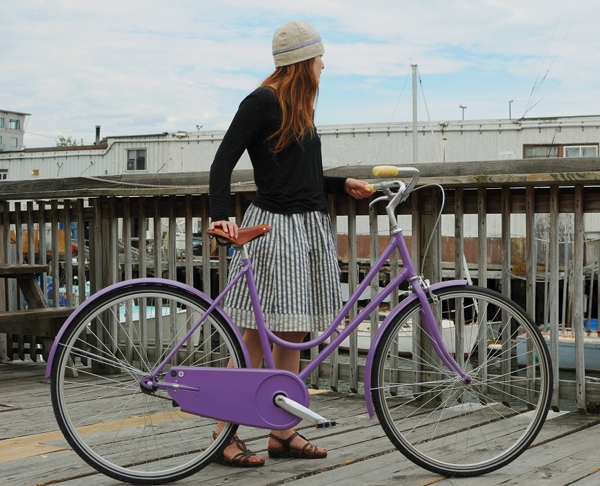 The Abici Granturismo Donna is a great choice for those looking for a sportier, lighter, more maneuverable step-through bicycle that is still more or less upright and comes with (or can be fitted with) all the trappings necessary for everyday transportation. Be aware that its handling and weight are radically different from that of classic Dutch bicycles and English roadsters, and whether this is a plus or a minus for you depends on your preferences. The price is very reasonable, and I would seriously consider buying the Abici for myself, if it were not for their choice of fork.
The Abici Granturismo Donna is a great choice for those looking for a sportier, lighter, more maneuverable step-through bicycle that is still more or less upright and comes with (or can be fitted with) all the trappings necessary for everyday transportation. Be aware that its handling and weight are radically different from that of classic Dutch bicycles and English roadsters, and whether this is a plus or a minus for you depends on your preferences. The price is very reasonable, and I would seriously consider buying the Abici for myself, if it were not for their choice of fork. 







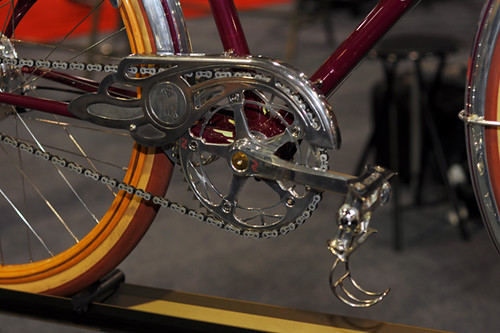 In the comments of recent posts there has been some interesting discussion about spending money on bicycles and accessories. I am not going to delve into some of the more existential issues raised, but one theme I found funny was the difference in our willingness to spend money on bikes versus accessories. Some are willing to spend a hefty sum on a bicycle, but don't really go for fancy components or accessories beyond the basics. Others would never spend more than several hundred dollars on a bike, but are perfectly happy to pay for component upgrades and fancy luggage.
In the comments of recent posts there has been some interesting discussion about spending money on bicycles and accessories. I am not going to delve into some of the more existential issues raised, but one theme I found funny was the difference in our willingness to spend money on bikes versus accessories. Some are willing to spend a hefty sum on a bicycle, but don't really go for fancy components or accessories beyond the basics. Others would never spend more than several hundred dollars on a bike, but are perfectly happy to pay for component upgrades and fancy luggage. 


 The heavy snowfall from last week slowed a number of teams, many have not made the summit. Since we're lite on route conditions, I'll share these recent climbing route photos. Here is the Nisqually Cleaver taken on May 30th.
The heavy snowfall from last week slowed a number of teams, many have not made the summit. Since we're lite on route conditions, I'll share these recent climbing route photos. Here is the Nisqually Cleaver taken on May 30th. 

 Copyright © .. by Rebeckah R. Wiseman
Copyright © .. by Rebeckah R. Wiseman

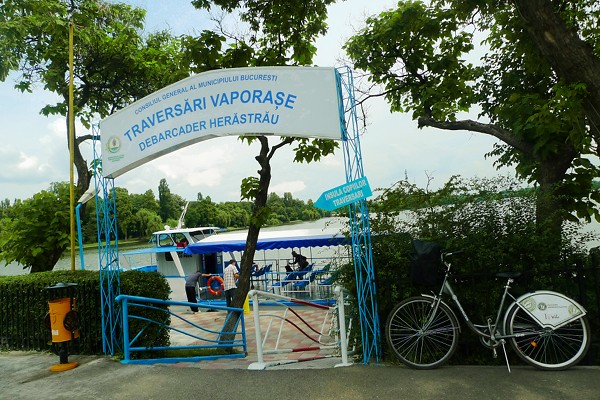 I am happy to report that since my previous post about Bucharest, I have actually cycled here - twice. The catalyst was a visit to theHerăstrău Park- a sprawling green space with lakes and alleys and rose gardens and too many other nice things to list.
I am happy to report that since my previous post about Bucharest, I have actually cycled here - twice. The catalyst was a visit to theHerăstrău Park- a sprawling green space with lakes and alleys and rose gardens and too many other nice things to list. Herăstrău Park and its surrounding neighborhoods seem to be
Herăstrău Park and its surrounding neighborhoods seem to be  "I ♥ Velo"
"I ♥ Velo"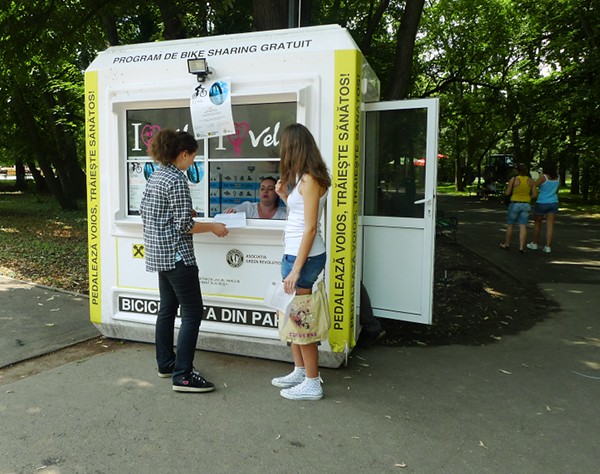 In a prominent spot in the park, there is a bicycle lot and a staffed booth. You come up to the booth, fill out a very short form, leave an ID (my US driver's license was fine), and get a free bike for 2 hours. If you are gone for more than two hours, you get charged a small fee. That is all. The people in the booth are very friendly and speak English. I was on a bike within 3 minutes of stumbling upon the booth.
In a prominent spot in the park, there is a bicycle lot and a staffed booth. You come up to the booth, fill out a very short form, leave an ID (my US driver's license was fine), and get a free bike for 2 hours. If you are gone for more than two hours, you get charged a small fee. That is all. The people in the booth are very friendly and speak English. I was on a bike within 3 minutes of stumbling upon the booth.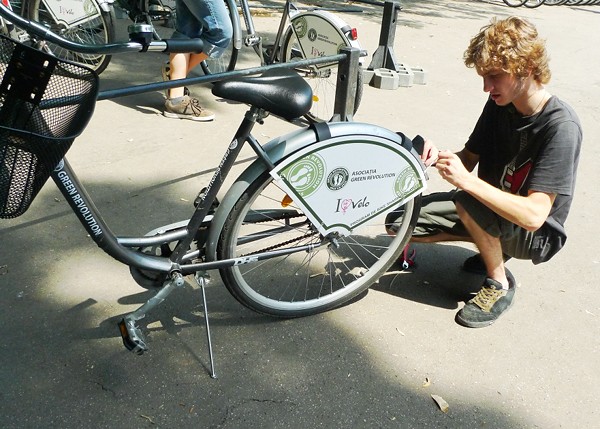 What I now understand about bike share in Bucharest, is that it is "de-centralised". That is, there are different companies that offer bike share in various parts of town, under different conditions. What I like about the
What I now understand about bike share in Bucharest, is that it is "de-centralised". That is, there are different companies that offer bike share in various parts of town, under different conditions. What I like about the  It was interesting to observe the attitudes towards cycling among those who use the bikes. On the one hand, it is definitely perceived as a leisure activity: the bikes are taken out for fun, not for transportation.
It was interesting to observe the attitudes towards cycling among those who use the bikes. On the one hand, it is definitely perceived as a leisure activity: the bikes are taken out for fun, not for transportation.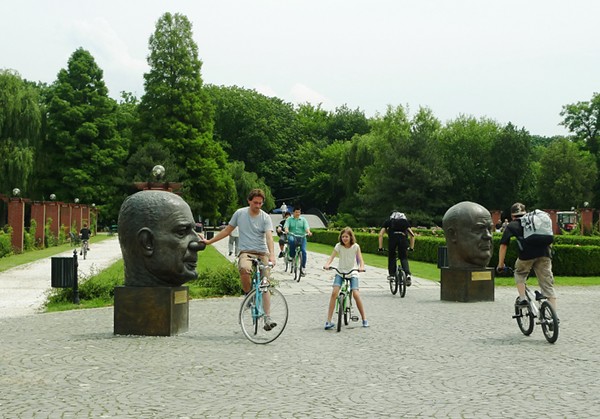 But on the other hand, they are not perceived as a form of sport: 90%+ of the people cycling are wearing their everyday clothing. It is a form of outdoor entertainment, like strolling and eating ice-cream, but not an athletic activity.
But on the other hand, they are not perceived as a form of sport: 90%+ of the people cycling are wearing their everyday clothing. It is a form of outdoor entertainment, like strolling and eating ice-cream, but not an athletic activity. There are bike paths throughout the park grounds, and they continue outside the park, connecting to the paths in the city center. However, locals tend to interpret the paths creatively. Directional arrows are ignored, cyclists make sudden stops and u-turns, and non-cyclists can often be found on the paths. As long as you go slowly, that's all fine, but speeding up is pretty much out of the question.
There are bike paths throughout the park grounds, and they continue outside the park, connecting to the paths in the city center. However, locals tend to interpret the paths creatively. Directional arrows are ignored, cyclists make sudden stops and u-turns, and non-cyclists can often be found on the paths. As long as you go slowly, that's all fine, but speeding up is pretty much out of the question.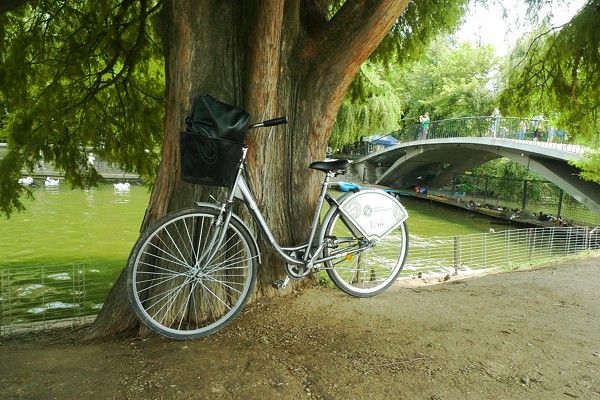 As for the
As for the  The basket is narrow, but deep - just big enough to fit my laptop bag if I squish it in sideways.
The basket is narrow, but deep - just big enough to fit my laptop bag if I squish it in sideways.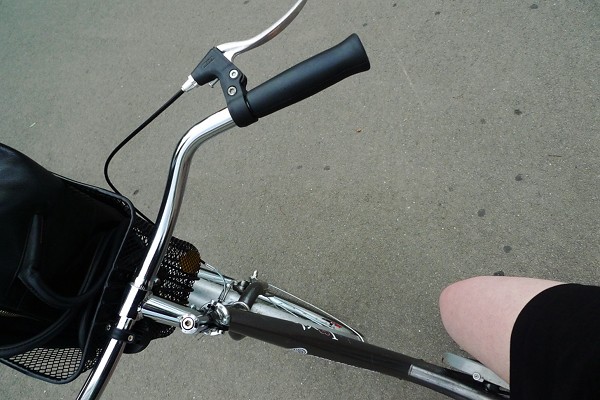 The ride quality is sufficient for slow rides in a mostly hill-free and car-free environment, but I don't think these bikes were meant to withstand much beyond that. Of course I was so happy to be riding a bike again, that it hardly mattered.
The ride quality is sufficient for slow rides in a mostly hill-free and car-free environment, but I don't think these bikes were meant to withstand much beyond that. Of course I was so happy to be riding a bike again, that it hardly mattered.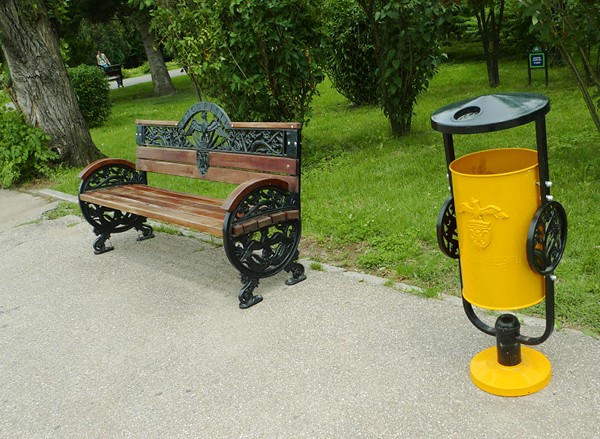 Taking a much-needed break from work, I cycled aimlessly around the park grounds, delighting in things like these ridiculously beautiful benches and trash receptacles.
Taking a much-needed break from work, I cycled aimlessly around the park grounds, delighting in things like these ridiculously beautiful benches and trash receptacles. Another gorgeous bench design.
Another gorgeous bench design. There are boat rides and outdoor cafes, sculpture parks and fountains, playgrounds and pony rides, and even peacocks. This park is truly amazing.
There are boat rides and outdoor cafes, sculpture parks and fountains, playgrounds and pony rides, and even peacocks. This park is truly amazing.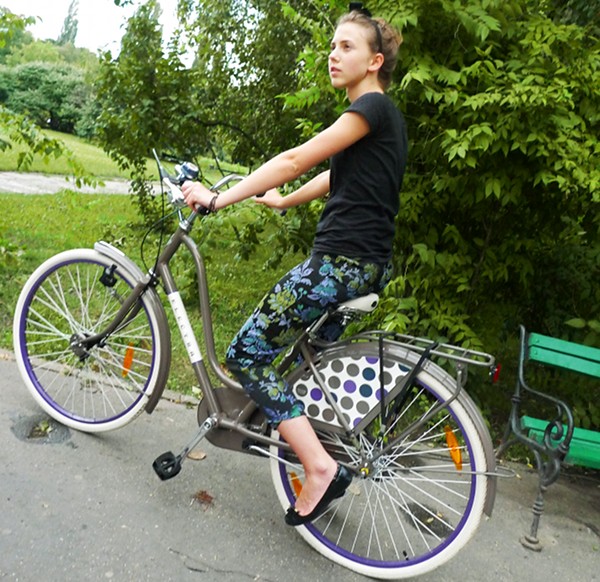 There were many others on bikes around, but one particularly lovely cyclist stood out and I could not help but approach her for a picture.
There were many others on bikes around, but one particularly lovely cyclist stood out and I could not help but approach her for a picture.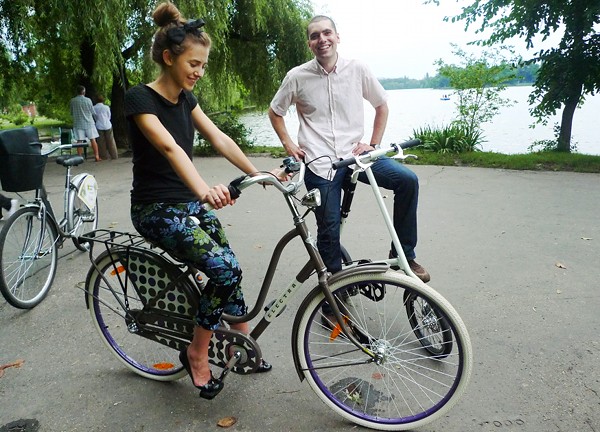 Her name is Ana, and it turns out she was test-riding a special edition
Her name is Ana, and it turns out she was test-riding a special edition  We had a brief conversation about the bike situation in Bucharest. Ana and George think that it is improving - with more interest in cycling and a growing popularity of classic bicycles. The
We had a brief conversation about the bike situation in Bucharest. Ana and George think that it is improving - with more interest in cycling and a growing popularity of classic bicycles. The 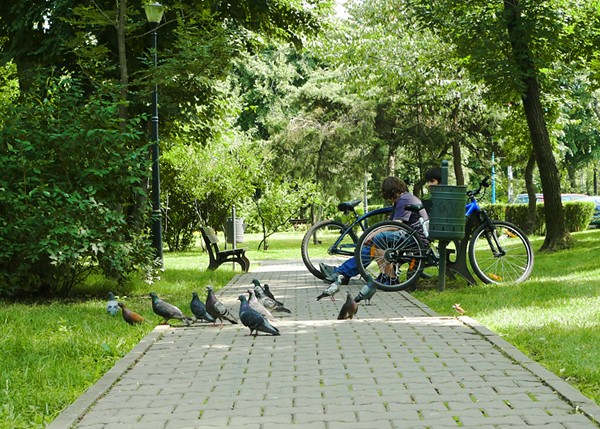 In the meantime, it is nice to see that at least in some contexts people in Bucharest are clearly enjoying cycling as a simple and casual activity.
In the meantime, it is nice to see that at least in some contexts people in Bucharest are clearly enjoying cycling as a simple and casual activity.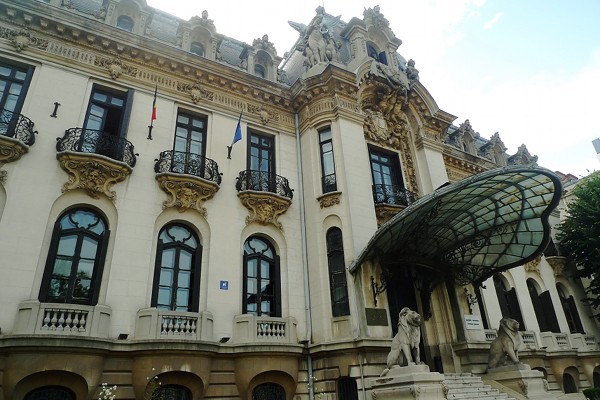 It is time for me to leave now and I want to sincerely thank all the locals who contacted me after my previous post. It was so wonderful to hear from you, and I regret that the nature of my trip did not allow me to organise any meet-ups. Please keep in touch; one never knows when fate might bring me to Bucharest again. And if you are a lone cyclist here who is looking for advice and resources, please visit: bikeblogbucuresti.blogspot.com, velobello.wordpress.com, www.portocalamecanica.ro, and simplybike.wordpress.com - I am sure they'd love to hear from you!
It is time for me to leave now and I want to sincerely thank all the locals who contacted me after my previous post. It was so wonderful to hear from you, and I regret that the nature of my trip did not allow me to organise any meet-ups. Please keep in touch; one never knows when fate might bring me to Bucharest again. And if you are a lone cyclist here who is looking for advice and resources, please visit: bikeblogbucuresti.blogspot.com, velobello.wordpress.com, www.portocalamecanica.ro, and simplybike.wordpress.com - I am sure they'd love to hear from you!